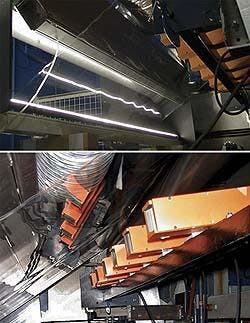Tension profile reduces waste in web systems
For manufacturers of web-based products such as paper, foil, and photographic film, variations in the web-tension profile, measured across the material, can cause major problems leading to process disruption, excessive waste, and plant damage. Consequently, the York Electronics Centre (York, England; www.yec.york.ac.uk) has developed an optical system to monitor on-line tension profiles in rolled materials; the system reduces the risk of variations in tension across the material that cause creases or tears.
The center's optical system uses a noncontact method to monitor the tension profile of the material. During operation, a crossmounted air nozzle displaces the material as it moves along the web. Simultaneously, a thin strip of light is obliquely projected onto the opposite side of the material, perpendicular to the rolling direction. When viewed, the line image on the web is distorted proportionately with web displacement. Any localized slack areas of the material will experience greater displacement. A camera system monitors the line distortion, tracks it, and passes details to a computer for analysis and recording. Furthermore, the web-tension profile can be adjusted as material inconsistencies are detected, avoiding drastic consequences.
When he designed the web-monitoring system, Tim Clarke, senior lecturer in control engineering at the University of York, used six KP-M1 cameras from Hitachi America (Woodbury, New York; www.hdal.com) to image slightly more than one-sixth of the web width. "To increase the horizontal resolution of the system by 3.8:1," says Clarke, "anamorphic lenses allow each camera to scan a width of approximately 250 mm with a vertical range of 90 mm." By using 50-mm-focal-length lenses on the cameras, the apertures of the anamorphic lenses were kept as small as possible to provide an effective image height of 120 µm.
"This allows the system to resolve to tenths of a millimeter over the full 1.5-m web width," says Clarke. Two Meteor II-MC frame grabbers from Matrox (Dorval, Canada; www.matrox.com) were used to digitize the six RS-170 outputs from the CCD cameras. "Hitachi's KP-M1 cameras were chosen because of their electronic shutter," says Clarke.
"Running six cameras through two Matrox Meteor II-MC frame grabbers enables simultaneous noninterlaced images to be acquired at 25 Hz, resulting in a 253-Mbyte/s data flow. The real-time web-monitoring software comprises an image-capture program and a line-tracking application and runs under Windows NT on an industrial PC with dual Pentium-II 450-MHz processors. After the images are captured, the line-tracking algorithm locates the line of light by looking for the brightest pixel in the scan. This algorithm also uses location information acquired from the previous scan to minimize search time.
The system has already proved successful in measuring the tension profile of web-based products. "Further developments will lead to a system that can automatically identify inconsistencies on-line for subsequent control action. A successful trial has just been completed with Eastman Kodak Co. (Rochester, NY; www.kodak.com), and more work is planned. York Electronics Centre is currently offering a trouble-shooting service that allows the Micro-Profile Monitor to be used as a short-term noninvasive diagnostic tool to identify and solve problems associated with web-manufacturing processes, equipment, and control systems," says Clarke.

